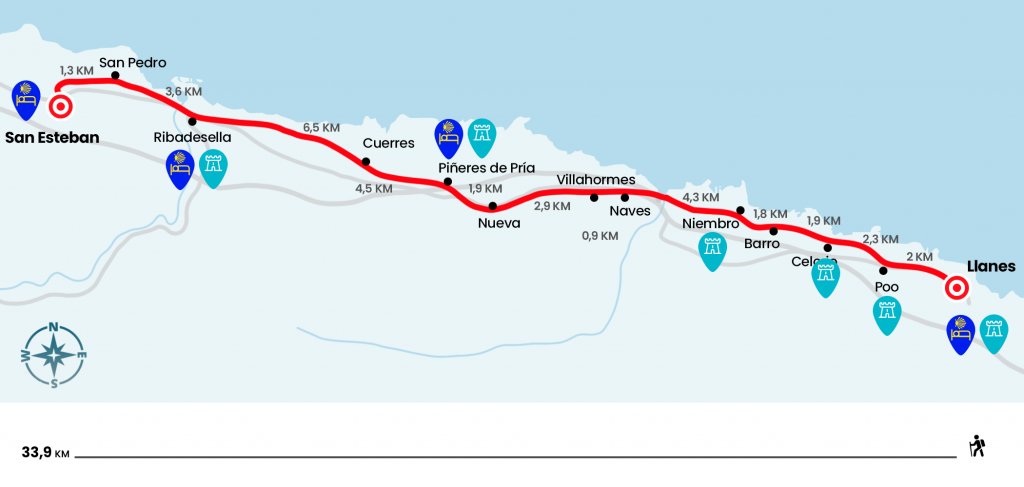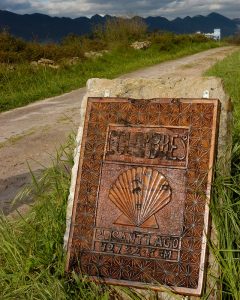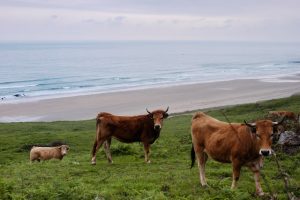Article translated by an automatic translation system. Press here for further information.
Stage from Llanes to San Esteban de Leces
Fun stage with many parishes in Llanes and Ribadesella
Information about the stage 18: Stage from Llanes to San Esteban de Leces

Enlarge map
Points of interest in the stage 18: Stage from Llanes to San Esteban de Leces
The route
The exit of Llanes is not conveniently signalized and by common sense we advance through AS-263 towards Ribadesella. The first night of the day is at the height of the Tanatorio Villa de Llanes and leads us to Poo on an old road (Km 2).
Arriving at the parish church with a white facade and tile, the best option is not to follow the signs and go to the train tracks and cross them. We continue along the road to Ribadesella and leave it on the right to take a road that leads to Celorio, village of Llanes that grew around the Monastery of San Salvador and from which there are currently only some vestiges of its Romanesque origin (Km 4.3). Leaving it aside we find our feet on the beach.
The following milestones are Barro and Niembro, two other tourist towns of the Council of Llanes. Among them is the church of Nuestra Señora de los Dolores. With high tide we will see this neoclassical temple reflected in the marsh. After this delight, a left hand path links to Niembro (Km 8). We went off the road and then we took a runway that flows back into the AS-263. For a pedestrian walk you can admire the Playa de San Antolín and the mouth of the Bedón River. An ad stamp thanks to the railway track that runs it.
Thus we reach Naves where more than a third of the stage has already passed (Km 12,3). We are now heading towards Villahormes through the old Camino Real that united Llanes with Ribadesella. On the verge of this journey is the chapel of the Ánimas, a humiliator of the 12th century that a group of vandals tore apart the dawn of September 1, 2012. From Villahormes (Km 13.2) we continue to Nueva de Llanes, a town with all the services where we can recover forces (Km 16.1). Attention because if we are going to sleep in Piñeres de Pría, the next locality, it is indispensable to buy in Nueva since in Piñeres there are no services, only a bar that does not give meals.
Again we retake the AS-263, leaving it on a path that starts right before the crossing level with barriers. We lined a long line after saving the A-8 to reach Piñeres de Pría (Km 18). In this locality there is a hostel of 8 places and from mid-May to mid-September 36 places are available in the rectoral house. The owner of the rural house, Rosa Cueto, formed the Association Halfway, of help to the pilgrim and have credentials. We leave Piñeres, in front of us, without taking the detour to the AS-263, because a badly placed cairn can confuse us, and later on, on the left hand arises a herbose section, which usually gets tangled with ease, which goes up, field through included, to the church of San Pedro that stands out for its bell tower.
We go down to Cuerres by the way that goes by the water tank and as the first houses pass, the most logical thing is to cross the way of the FEVE, however the official route continues to the right giving a great rodeo. In Cuerres, a German family offers traditional welcome at home. We arrived at the medieval bridge of Aguamía, recently restored, and thus entered the Council of Ribadesella (Km 22.5). Later we did cross the road and follow everything straight to Ribadesella, to which we arrived in more than an hour after touring the sites of Sobars and Pozu la Arena.
The entrance to Ribadesella is through the back door, in principle it does not stop any attractiveness but suddenly we are immersed in the street plot of the El Portiellu district. We descend through the historic town of the villa looking for the driveway over the Sella, an objective that is also marked by thousands of palists every summer when they take the exit at the Arrionda bridge in the International Descent (Km 29).
In the past, when there was no bridge, the pilgrims saved the river by boat from the chapel of Santa Ana . Now no, so if our goal is San Esteban, we will cross the concrete bridge to get into modern Ribadesella. After the Sella, the signals make us turn right. With a slight rodeo we will reach the promenade of the beach of Santa Marina, ending on the local road that leads to San Pedro (Km 32,6), and that after a very intense repecho (at some point is more rested climbing in zig zag) will leave the village of Abeu aside. A Jacobean cairn guide left to the next hostel in San Esteban de Leces (Km 33.9).
The difficulties
Remarks
In images
What to see, what to do
The hostels

¿Do you want to send any photo of "The Camino de Santiago"?
If you have any photos of "El Camino de Santiago" that you want to share with us, you can send them to us and enlarge the photo gallery


Forum: What pilgrims think about the Camino de Santiago
See all